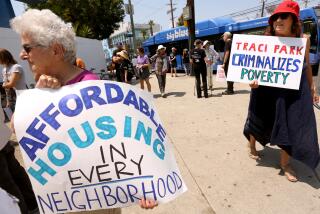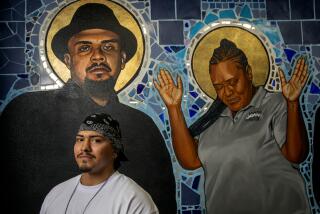Where We Are and Where We’re Going at United Way : Report Urges Local Units to Think More About Society’s Needs, Less About Fund-Raising Skills
America’s largest fund-raising organization is being advised in a soon-to-be-released report to involve more minorities and to spend more money helping children, single-parent families, the homeless and the chronically unemployed.
The study for United Way of America advocates fundamental changes for the 2,200 local United Ways, with a growing emphasis on social planning and less emphasis on raising money.
The study, the third in a series developed over seven years, also suggests the number of middle-class givers is declining, which may force the adoption of new and costlier fund-raising techniques, including door-to-door solicitations.
Increasingly, the study found, Americans want to pick which charities get money that they give through payroll deduction instead of having United Way act as a middleman, deciding how to divide donations among health and human services charities.
These and other findings are in a report titled “What Lies Ahead--a Mid-Decade View.” The report, prepared by 38 leading futurists and issues managers from major American corporations, labor unions and think tanks, will be published next week. United Way of America, the national coordinating office for local United Way campaigns, provided an advance copy of the report to The Times.
“We may be coming full circle back to our early days (six decades ago) when the emphasis was more on social welfare planning than on fund raising,” said Steve Delfin, a United Way of America spokesman at its headquarters in Alexandria, Va. “United Ways may be moving from being fund-raising organizations back to social planning and community catalyst organizations.”
“The emphasis in United Way is on health and human care services,” said William C. Ashley, issues manager at United Airlines, who chaired the Environmental Scan Committee, which conducted the study.
“If United Way is to play a role in the community, it is to be a catalyst. . . . The question is, ‘What does United Way want to do when it grows up?’ ” Ashley said.
Most Americans think of United Way as the fund-raising organization they can support through deductions from their paychecks. Committees of volunteers decide how to allocate the donated money among those charities that belong to the umbrella group. Most member charities get only a fraction of their budgets from United Way campaigns, but having the United Way imprimatur also helps them raise money independently.
What happens in the United Way movement has a major impact on the quality of life for millions of Americans.
More than 37,000 health and human service charities get part of their money from United Ways, which will raise more than $2 billion this year. About half the money goes to about 20 major charities, notably major health charities such as the Red Cross and traditional youth-serving groups such as the Boy Scouts.
The study’s findings are certain to generate serious debate within the United Way movement over the sensitive issue of allocating limited funds. In most United Ways, traditional charities are guaranteed an allocation each year--provided the annual fund-raising goal is met--and a share of any increase in donations.
In the few cases where local United Ways have proposed reducing or eliminating funds to longtime member charities, it has provoked deep and divisive debates, interviews with United Way executives across the country indicate.
Intensification of Debate
Delfin, the United Way of America spokesman, predicted that the study would intensify that debate as well as stimulate discussion of whether United Ways should place greater emphasis on social welfare planning and identifying new social problems.
Locally, United Way in Los Angeles President Francis X. McNamara Jr., who had not seen the study, said that he believes his organization is in the forefront of the United Way movement in emphasizing social planning and prompting other organizations to deal with emerging social problems.
Since the late 1970s, 38 of the top planners and futurists working at major corporations, labor unions and government agencies have been studying social forces that will affect United Way’s future. Such studies are known in industry as “environmental scans” because they examine the external environment an organization must operate in.
Chief executive officers of major corporations who serve on United Way of America’s board wanted the studies, according to Ashley.
The national study focuses on implications for United Ways as they plan for the next five years and the rest of this decade.
The study notes that “growing minority populations will require that minorities play an expanded role in the United Way system as donors, volunteers and beneficiaries of United Way-funded programs.”
The movement has been repeatedly criticized, both by outsiders and from within, for having too many white males, many of them top corporate executives, in key volunteer positions.
Major Social Issues
The report identifies chronic high unemployment and the “burgeoning” problems of the homeless as major social issues that United Ways need to address, suggesting that they work with religious charities to address these problems.
Children, who make up the bulk of the poor in America, may become increasingly dependent on private charity, partly because government is directing less of its limited welfare budget toward them, the report states. The number of poor children in households headed by women has grown 50% between 1969 and 1981, from 4.2 million to 6.3 million, Census Bureau data shows.
The study notes that government health and welfare spending on the elderly is rising. “If government resources must continue to focus away from poor children and focus on the elderly, the private human services sector may have to focus more on this younger group,” the study says.
Programs to serve “single-parent families, especially those with teen-age mothers, with latchkey children and the high number of those (children) that are poor” are also needed, the study states.
“Perhaps United Way has gotten away in the past 20 years from funding needs of the economically impoverished--services to the indigent, the homeless--services that relate to hard economic times, like providing food and shelter,” Delfin, the United Way of America spokesman, said.
Women and Children
Raymond P. Ewing, director of issues management at Allstate Insurance Co., and a member of the study committee, noted that “well over half of the people below the poverty line are women and children.”
He said that because working mothers who head families have limited time for their “parenting role and homemaking role and limited economic opportunity, they need more support during the period when their children are growing up. . . . That seems to be the most pressing problem in the near term and probably into the next decade.”
Ewing said United Way planning committees need to recognize that despite the economic growth since the 1982 recession, poverty is increasing in America.
On the fund-raising side, the study anticipates a “polarizing trend” in future employment. The study predicts there will be a relatively few highly skilled and highly paid managers and professionals and many low-paid clerical and technical workers.
The ranks of well-paid manufacturing and middle-management workers, who have been a key component in United Way workplace fund raising, will thin, the study predicts, and therefore giving from these groups will shrink.
Chronic Unemployment
And the study suggests unemployment “will remain a chronic problem” with up to 8% of the labor force out of work. In addition, “many workers hover on the brink of unemployment” because of structural changes in the economy, the study states.
The report also warns United Ways to plan for a recession in 1985-86, which could affect the amount people give.
Changing employment and corporate ownership patterns pose serious challenges to fund raising, according to the study.
Lower-paid service workers, whose numbers are increasing, generally do not have as much money to give as unionized factory workers, the study states.
The increase in foreign ownership of American companies requires “new campaign approaches and methods of educating people about United Way” if these foreign owners are to contribute.
New Challenges Posed
In addition, the growth of small companies poses new challenges to the payroll deduction plan that accounts for about half of all United Way revenues. Fund-raising costs will increase as these smaller companies are organized, the study indicated.
(One of the major attractions of payroll fund raising is its low overhead costs. United Way in Los Angeles reports that only about 7.5% of donations go to fund raising and administrative overhead. These same costs can consume up to 75% of donations to direct mail appeals and television fund-raising appeals, although 25% is more typical.)
The study predicts growing demands by workers to specify which charities get money they donate through payroll deduction. Now most workers who participate decide only how much to have deducted from their paychecks while letting United Way committees decide how to divide funds among charities.
The issue of designating where contributions go--known as “disintermediation”--is one of the most crucial and sensitive issues in the United Way movement.
In some United Ways, givers can designate a specific charity. However, charities are discouraged from telling their supporters about the existence of these so-called “donor option” plans and many givers are unaware of them.
United Ways, which are known as federated organizations because they are composed of many charities, generally have fought attempts by Black United Funds, women’s funds and other competing federated groups to obtain equal access to workplace fund raising.
“For federated fund-raising organizations, disintermediation will become an increasingly significant phenomenon,” the study states.
‘Underlying Dynamic’
” . . . An underlying dynamic is the search by individuals for ways to exert control over their lives and to resist control by large organizations and institutions.”
Challenges to United Way’s often exclusive position in payroll deduction fund raising will continue and grow, both creating competitive pressures for United Ways and pressures to change fund allocation procedures, according to Ashley, the chairman of the Environmental Scan Committee.
“The public’s thinking is that allocations of funds should follow wishes of the donors,” he said. “We should make it easier for the donors to have a say in how it is spent.”
Ashley said the committee’s last study sold more than 50,000 copies to United Way member agencies and others and he expects similar sales of the new report.
“It is more and more obvious to me that local United Ways are using our studies because they are able to speak with some authority about the issues,” Ashley said, adding that throughout American society “the number of people seriously monitoring changes and looking at the future and factoring it into their decisions is very small.
“This study serves as an impetus to local United Ways to do their own local scan and to look at their own communities,” Ashley said.
Graying of America
Ashley cited the graying of America and the trend toward shorter work weeks as trends that may significantly benefit charities.
He said older people often have time to be volunteers and have surplus income to donate.
The study speculates that by 1990 the 36-hour work week will be common, with many workers putting in four days of nine hours each. This could result in greater volunteer activities by working people.
He said by identifying trends, such as the increasing foreign ownership of American corporations, the study is intended to help “position the United Way to avoid confrontation in these kinds of areas. . . . If you suddenly find foreign ownership of American corporations means less and less giving by corporations, the question is how do we involve these foreign owners? How do we adjust, over time, to this?”
More to Read
Sign up for Essential California
The most important California stories and recommendations in your inbox every morning.
You may occasionally receive promotional content from the Los Angeles Times.










